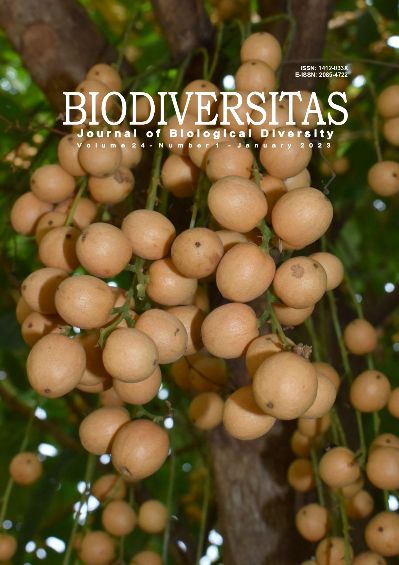Genetic variation of Limnophora marginata Stein, 1904 (Diptera: Muscidae), associated with an altitudinal gradient in Pedro Moncayo Canton, Pichincha, Ecuador
##plugins.themes.bootstrap3.article.main##
Abstract
Abstract. Aguilar KEV, Vivas AYS, Acosta-López C. 2023. Genetic variation of Limnophora marginata Stein, 1904 (Diptera: Muscidae), associated with an altitudinal gradient in Pedro Moncayo Canton, Pichincha, Ecuador. Biodiversitas 24: 269-275. Analyzing heterogeneity in insect populations is relevant to understanding its biology. Thus, we analyzed the genetic variability of two populations of “hunter-flies”, Limnophora marginata Stein, 1904 associated with an altitudinal gradient in the Tocachi and Jerusalem localities, in the Pedro Moncayo Canton, Ecuador, using Polymerase Chain Reaction-Restriction Fragment Length Polymorphism (PCR-RFLP) of the mitochondrial Cytochrome oxidase I gene. Thirty alleles were detected from analysis with five restriction enzymes; the percentage of polymorphic loci was higher in Tocachi (96.67%) than in Jerusalem (80%). Haplotypes were generated with the corresponding alleles, resulting in a different haplotype for each analyzed individual. Several estimators were used to characterize the population structure. The Analysis of Molecular Variance (AMOVA) evidenced the existence of higher intra-population variability (94%) than inter-population (6%), showing similar information to that found through haplotype analysis. The Fst fixation index indicated that there is no genetic difference between populations (0.056, P<0.05). Nei's genetic distance and Nei's similarity index indicated that L. marginata populations did not show differences between populations. From the results we deduce that the evolutionary force that may be modelling the existent genetic variability may be gene flow, thus establishing a low inter-population genetic structure. The mitochondrial DNA Cytochrome oxidase I gene was an advantageous molecular marker to obtain results that established intra and inter population variability. The characteristics of the mitochondrial DNA were useful to successfully apply the PCR-RFLP technique. Our findings highlight the existence of ecosystem connectivity between L. marginata populations despite altitudinal and habitat differences.

